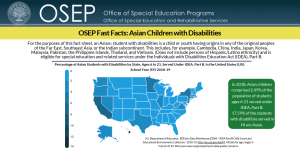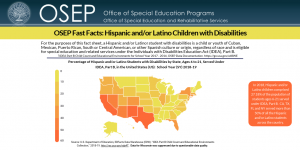By the Office of Special Education Programs
The Office of Special Education Programs (OSEP) released an updated Fast Facts: Children Identified with Autism, which takes an updated look at our data on children whose primary disability is autism. We revised and updated our very first (and one of our most popular) OSEP Fast Facts.









![Office of Special Education and Rehabilitative Services’ Office of Special Education Programs. OSEP Fast Facts: Children Identified With Emotional Disturbance. Percentage of Students with Disabilities Identified with Emotional Disturbance, Ages 6 to 21, Served Under IDEA, Part B, in the United States: School Year 2018-19. Map of United States. In SY 2018-19, the percentage of students with disabilities identified with emotional disturbance is 5.45%. States report a range from 1.65% to 17.36% of students with disabilities identified with Emotional Disturbance. Source: U.S. Department of Education, EDFacts Data Warehouse (EDW): “IDEA Part B Child Count and Educational Environments Collection,” 2018-19. https://go.usa.gov/xdp4T. Data for Wisconsin suppressed due to questionable data quality. Iowa does not use the specific disability categories when classifying a student as eligible for special education.]](https://sites.ed.gov/osers/files/2020/05/2020-osep-fast-fact-ed-thumbnail-1024x512.png)
